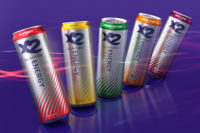When it comes to deciding which way to go with inks for labels and the flexible packaging market, what is the correct solution? Flexography or digital are the key printing processes that need to be considered.
In recent years, the cost of digital printing is decreasing. In fact, so much to the point where it is becoming even more attractive to label and flexible packaging converters for customized, short-run productions. But it really is much more than that. There are several key factors for the strong growth of digital printing in this market segment.
First, the speed of the equipment is getting faster and faster. The major influencing factor is the printhead manufacturers themselves. They realize that to become a competitive alternative to flexography, they need a printhead that can print much faster than just two or three years ago.
Speeds then were only 40 to 60 linear feet per minute. In other words, great for short runs but not really that compelling when you were thinking about keeping up with a flexo press. Today, the new printheads can be run at much higher speeds of 250 to 300 linear feet per minute. Thank you printhead manufacturers!
The next critical factor is that ink companies have a better understanding of the importance of creating low-migration UV ink sets that can handle the very stringent requirements for this market. In labels or flexible packaging, the process extends much further than the printing process. It includes the lamination and coating of packaging materials that are used in indirect and direct food contact applications.
Of course, there are some questions. Can the films or packages be heat-sealed or laminated without degradation of the ink or its performance characteristics? Does the coating penetrate or seal the ink to create a unique bond or protective layer? Does the ink work well in retort pouches or heat-treated food applications?
These are just a few of the challenges regarding UV ink sets. All must comply with very strict health and safety guidelines insuring that the inks will not damage the product contained or harm the consumer purchasing the product. That’s no small task by any measure, but this is one of the key areas where significant strides have been made over the last several years regarding the performance of digital inks.
Another factor is electron beam (EB) inks have started to appear in the digital printing world. In conventional UV printing inks, photoinitiators are a part of the formulation. UV inks are exposed to a light source, which emits energy having a specific wavelength of light specified in nanometers. The exposure is used to activate a photoinitiator contained in the product.
This begins the polymerization or curing process, which happens very rapidly, usually specified in nanoseconds. The concern with UV inks is the migration of any uncured portion of the formula or photoinitators. Migration in this case means that some of the components of the ink could migrate through the film into the contents of the package itself. This is where and why EB inks are gaining in popularity.
The main advantage of EB inks is they do not require photoinitators. The lack of photoinitiators means that EB inks are low-migration — making them ideal for food and pharmaceutical packaging and especially so in the flexible packaging market, which includes thin films and foils. The general feeling is that this will gain in popularity and help drive the cost of the EB curing units down over the coming months and years.



